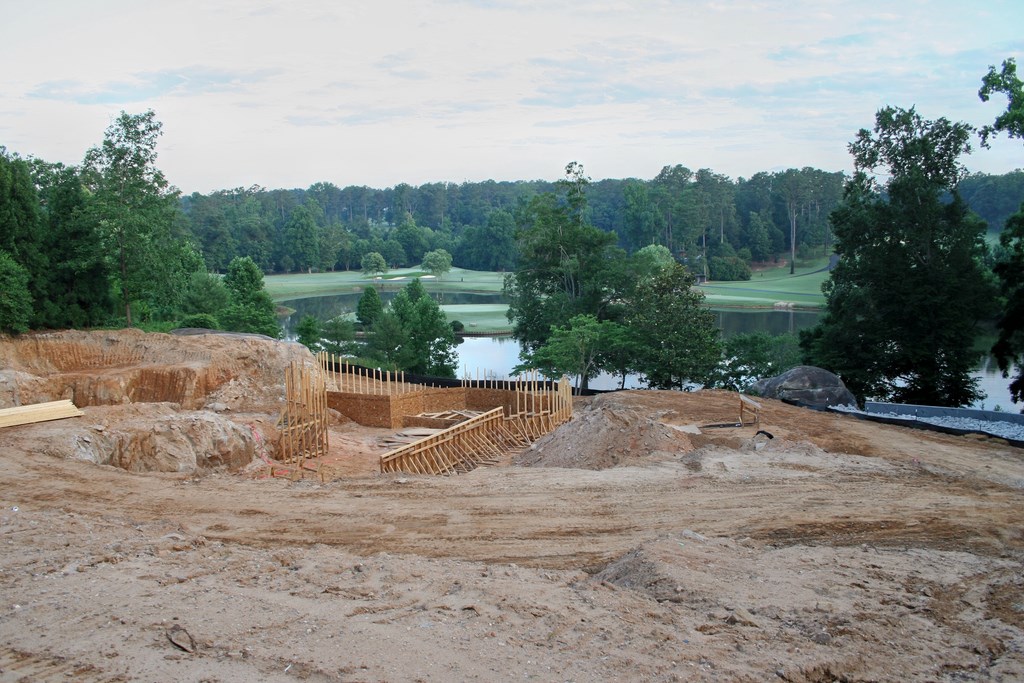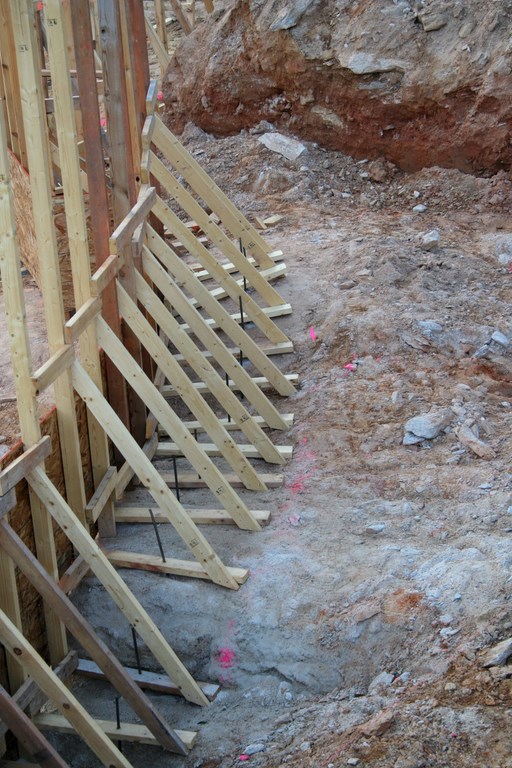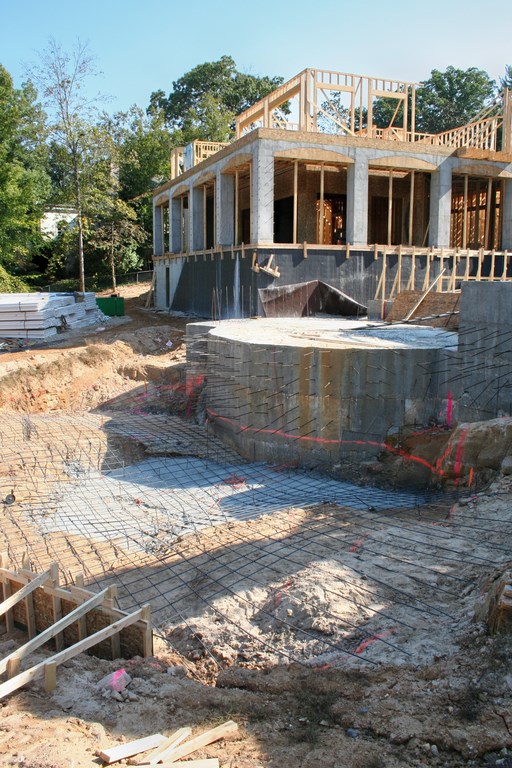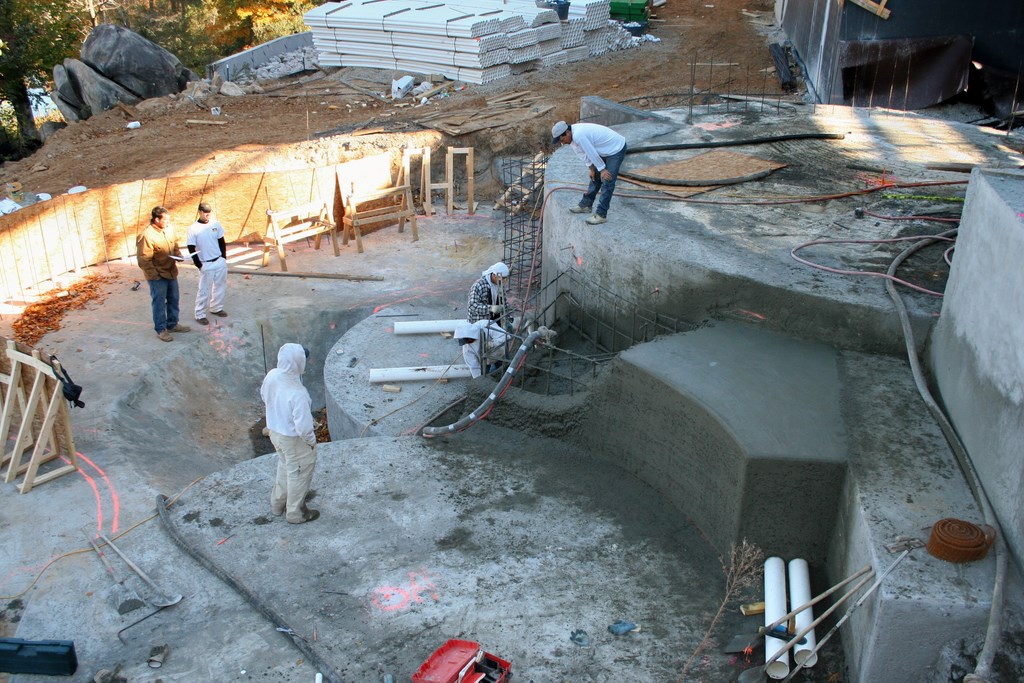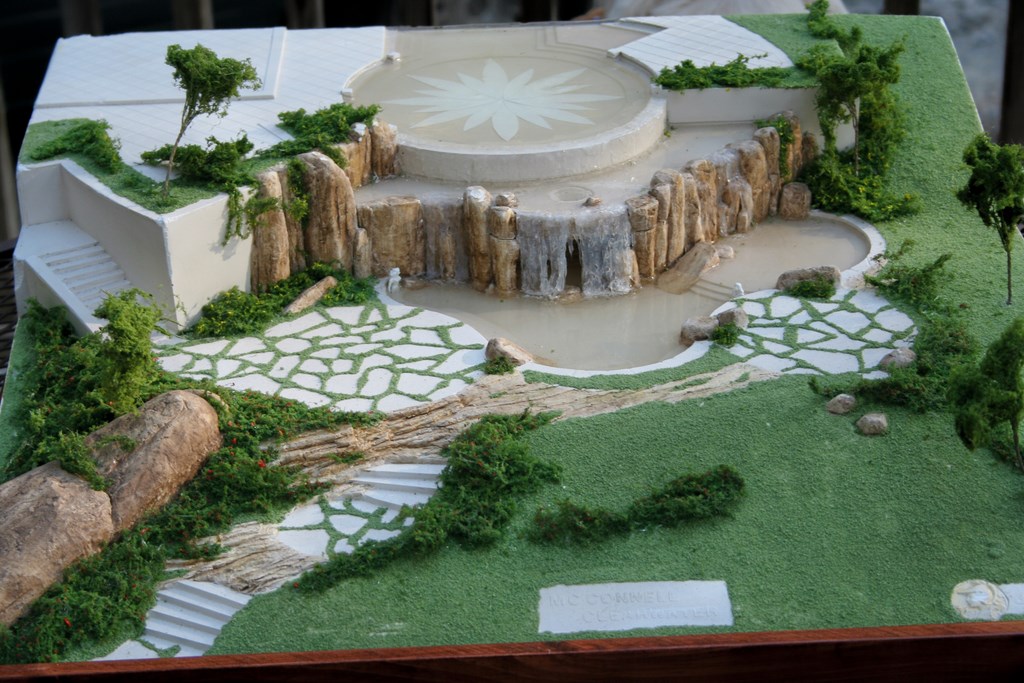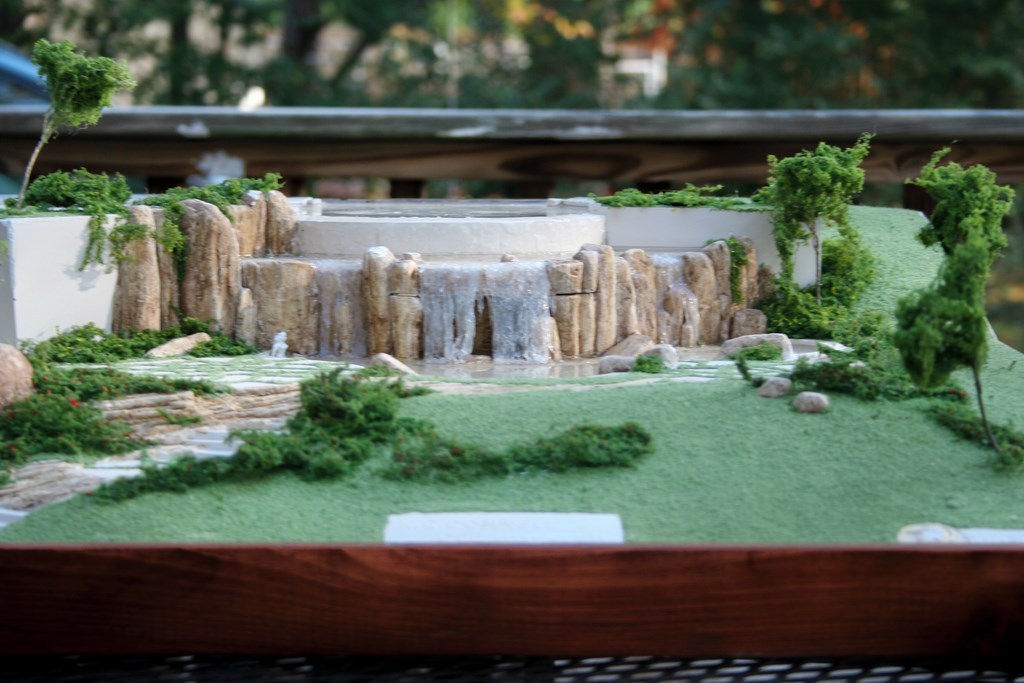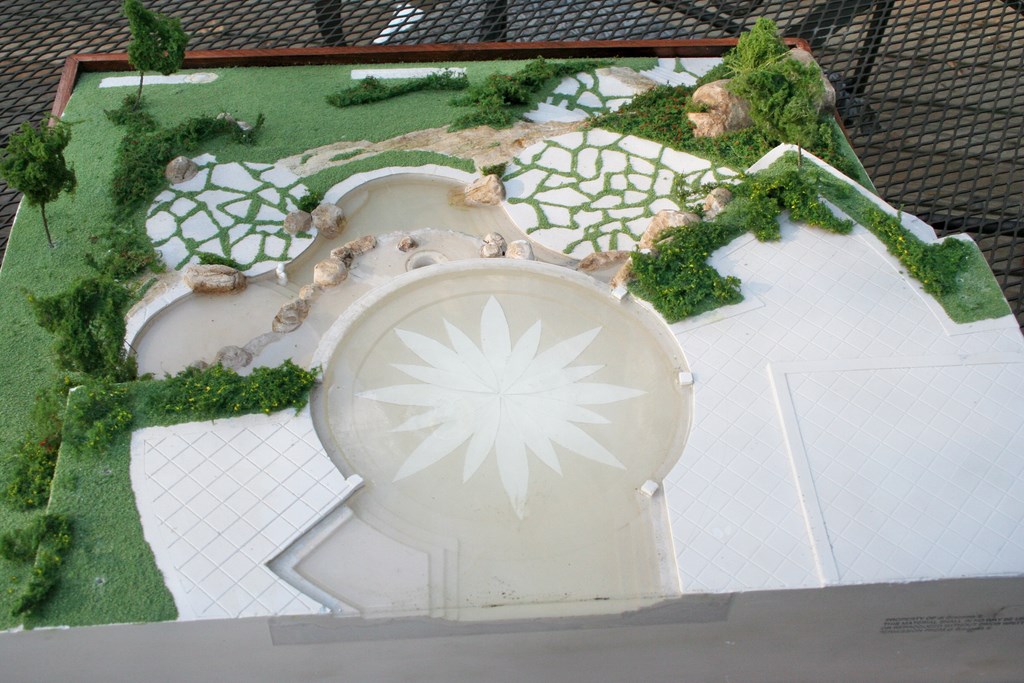Collective Effort

It’s a tale of two visions.
One contingent in the family wanted a formal, architectural pool that would reflect the geometry of the home. The other wanted to borrow the natural look of the lake and rock formations that flowed down the sloping backyard. Such divergent themes are generally difficult to blend into a coherent design, but I managed to do it with a little help from some friends.
The project, which involves placing a formal, geometric pool atop a formation of artificial rock that looms over a grotto and lagoon-like pool below, is still under construction at this writing. At this point, I’d have to say that the results should be just as spectacular as the design process was arduous.
My company is based in Raleigh, N.C., which, although it is hardly a backwater, is not exactly at the epicenter of watershape design or construction expertise. To integrate this diverse clutch of elements, I felt a need to seek out the best talent I could find, wherever it turned out to be. My hunt began and ended in California, where I engaged the services of artificial-rock guru Philip diGiacomo from Azusa, structural engineer Ron Lacher from Tustin and watershaper/landscape architect Mark Holden from Fullerton – each one a professional clearly able to deliver a level of quality far in excess of the clients’ expectations.
The key to attracting their attention was the unusual nature of the conceptual design.
FAMILY MATTERS
Let’s set the scene: From the home, all that will be seen is a formal body of water overlooking the lake beyond. As you move down the slope from the upper terrace, you begin seeing a wealth of rich natural textures surrounding a lower lagoon-style pool. The upper space is connected to the home to please one side of the family, with the lower one tied into the natural surroundings to please the other.
Behind this simple solution, however, is some dazzling complexity – so much so that I knew I would have to elevate my game to a point where I needed expert assistance. I have to say that having the opportunity to work with these top professionals has been both enjoyable and extremely educational.
First of all, I learned that in design work, the whole truly can be greater than the sum of the parts. Each of us contributed ideas to the mix, but the power of the collaboration expressed itself most clearly in the fact that everything we did was subordinated to a greater goal of delivering responsible solutions to the clients.
| To build on the steeply sloping site, we had to remove the existing material down to bedrock, then add structural fill up to the bottom of the watershapes. We also had to clean and shape the bedrock before moving on to the forming stage, which at that point involved a sequence of freestanding structures set atop a compacted but boulder-strewn base. |
I also learned with great clarity that being a great watershaper does not mean that you personally have to be the best excavator, for example, or the best tile setter. Instead, it means that you are able to assemble people, ideas, services and products and carry them all along at a level that produces quality environments that have positive influences on people within them.
But getting back to the project at hand: It all began about two years ago, when the clients and their homebuilder approached me with a hand-sketched plan for house on a lot overlooking a lake – a truly spectacular location. One of the clients asked me if there was any way we could “incorporate a little pool” in the layout.
Not knowing what I was about to get myself into, I told them it would be no problem. I sketched an initial shape on the concept plan as a placeholder, and we parted company at that point with an agreement that we’d revisit the pool later on as the house plans took shape.
As is my usual practice, I began asking questions before we parted about how the watershape was to be used and what they had in mind when it came to appearance and style. Little did I know that these two simple questions would end up being the most difficult to answer and that I had plunged myself into a gulf between sharply divergent interests in the family.
MODELING VISIONS
As mentioned above, one camp wanted a formal watershape that would function primarily as a visual element and a match for the clean lines of the Mediterranean-style house. The other part of the family wanted a lagoon-style watershape with waterfalls, slides and places to play. Given the site, both ideas were entirely appropriate; given the strong wills in the family, they also seemed at first to be irreconcilable.
In sketching up ideas after our initial meeting, I lit on a bi-level solution that dealt with the split-personality issue and, to my delight, found that everyone was happy with it. We went our separate ways, but in the year that followed and as home construction moved along, we met occasionally to discuss and incorporate more and more details into the design.
| This project required an amazing volume of concrete, which we delivered to the shells by whatever means was needed to speed placement. As we did our work on the upper, formal pool, the general contractor was moving forward rapidly with construction of the home above and around us. |
I could see through this process that the clients were truly excited about the design and were delighted by the fact that it met both visions for the space. But as our discussions continued, I could also tell that we were headed toward a project that would be enormously complex.
This is when I turned to my trio of experts. A major portion of the lower pool was to feature artificial rockwork, which led to my meeting with diGiacomo. An enormously creative artist, he immediately came up with a range of suggestions. Before long, we gave him full artistic authority to transform my abstract rock outcroppings into his own cohesive vision.
We stayed in contact in the months that followed, relaying ideas back and forth until di Giacomo built his maquette for our project – an exact scale model of the setting. It was simply amazing: When we presented it to the clients, they were able to visualize their watershape in a three-dimensional view rather as a flat piece of paper, and their excitement grew by leaps and bounds.
| With the main portion of the upper pool nearing completion, we jumped right into the middle and lower pools, which were separated from the upper pool structurally and hydraulically – and aesthetically, as we managed the key transition from the formality of the home to the natural character of the slope down to the lake. |
The clients asked for just one change: They wanted increase the size of the slide, which diGiacomo had ingeniously designed to look like a piece of rock that had broken off a larger outcropping.
His response was nothing short of profound: “I don’t mind compromise,” he said. “What I really want is to have the project change the quality of your lives as a family. A house, a pool, a rock are all meaningless crap unless they can be designed to enrich you and fill your family with enjoyable experiences that will stay with you forever.”
The room went silent. I looked around, and everyone from the clients to the homebuilder and even the secretary had small grins on their faces and were all nodding in agreement. He had just put into words a goal toward which all architects, designers and watershapers should strive: not awards, not peer recognition, not money – those are rewards that flow from changing the quality of people’s lives and are not goals themselves.
HARD GROUND
With that, the entire project took on the air of work being done for a higher purpose: It wasn’t about creating a project with lots of bells and whistles, but was instead about creating a space in which a range of human experiences could and would take place.
I was truly inspired and eager at this point to get down to the work of seeing the project come to fruition – and that meant it was time to engineer the structure and generate detailed plans, which is where Ron Lacher’s and Mark Holden’s firms stepped into the picture.
The project was being built on a former home site with extremely rocky underpinnings on a slope that drops approximately 80 feet from the front of the house to the back of the lower pool’s patio before dropping another 60 feet or so to the lake. I knew this called for expert engineering, so I turned the plans over to Lacher. We immediately agreed that the greatest challenge would be stabilizing the subsurface and building the watershapes in such a way that they would not move.
| The splitting of the circulation system from one integrated system into two separate ones for the upper and lower pools dramatically increased the cost and complexity of the plumbing, but in the long run the initial investment will make for much greater energy efficiency and lower ongoing utility bills. |
Test borings and soil sampling indicated that the soil on site was not adequate to support the watershapes. After a great deal of discussion, it was decided to remove all soil from the site down to bedrock – and that the bedrock itself would have to benched and cleaned to allow us to install structural fill up to the bottom of the watershape structures.
With the substructure issues solved, Lacher turned to the pools themselves. These turned out to be fairly routine, although there were a handful of elements that required special attention. These included a 35-foot waterfall constructed of 12- to 20-inch-thick concrete and limestone that needed to be self supporting as well as a large diGiacomo-generated, rock-covered grotto with skylights and a 16-foot-wide opening.
Then there was the Big Question: Should the entire structure be monolithic or should its various elements be separated by isolation joints? Lacher’s team crunched the numbers and eventually came back with the answers we needed: The waterfall stayed as designed, the opening to the grotto was shortened by a few inches and the upper pool was to be isolated from the middle and lower pools by a one-inch isolation joint.
Now that the structural issues were settled, we could begin work on the other key design components.
EFFICIENCY QUOTIENTS
At this point, I turned to Holden to develop the hydraulic design and generate a full and complete set of working drawings that would drive the project to completion. He was the perfect choice, as I had long admired his work and had been particularly impressed by his compulsion to get every detail of his plans just right.
We basically had two vanishing-edge pools, a slot-overflow pool, a tall waterfall and a spa – all interconnected in my conceptual design. Holden took that scheme and generated a preliminary set of plans for review and discussion with the client.
It was a crucial meeting, and the clients expressed hesitation at what looked to be relatively high energy-consumption levels of the fully integrated system. After some creative back and forth, they expressed their willingness to make a higher initial investment if it meant a reduction in ongoing energy consumption.
This new goal of greater energy efficiency meant scrapping about 80 percent of the hydraulic design and basically starting over. The big system pumps fell off the drawing board, replaced by a series of smaller pumps – and then he followed through in reshaping what had essentially been a single body of water into several smaller systems that will run and be heated independent of each other.
| Philip diGiacomo built this maquette for the site before construction began, and it did an amazing job of helping all of us – especially the clients – visualize quite precisely how everything would come together from every conceivable angle and exactly how the key formal-to-natural transition would work. |
Starting at the top, Holden isolated the 35-foot waterfall from the upper pool, dramatically reducing heat loss from the pool. Then he isolated the spa while preserving the illusion that it spills down the steps to the tanning shelf in the pool. Next, he separated the upper pool from the lower pool by having the vanishing edge flow into a slot on the backside of the wall for re-circulation only within the upper pool. This gives us the ability to heat the upper and lower pools separately.
Through these changes, Holden’s team was able to reduce projected energy consumption by more than 65 percent, meeting the clients’ desires while not sacrificing even a single design element of the watershape complex. That simple fact was extremely gratifying: Through all the effort to date, my basic design scheme has held up, and the bi-level complex my clients and I had begun envisioning a year earlier is actually taking shape.
At this point, we’ve moved beyond the planning stages and have begun construction work on site. I can say without hesitation that surrounding myself with expertise has been crucial to delivering excellence. Those I brought in to work on the project have exceptional talent, and what impresses me most is that each has been willing to set ego aside and pitch in with real passion.
They all performed their individual roles to perfection and were each perfect team players. In retrospect, I suppose I could’ve tackled this project on my own and done a creditable job, but I have the sense that the process would have been very different, much harder and probably less assured of success. Bottom line: Their participation removed any uncertainty and promises extraordinary results.
Frank Bowman is president and founder of Frank Bowman Design, a high-end residential swimming pool design/construction firm based in Wake Forest, N.C. A long-time competitive swimmer and lifeguard, Bowman started in the pool industry while attending the University of North Carolina, running a full-service aquatic-management firm for local commercial and municipal pools. After graduating in 1997 with degrees in accounting and business management, he moved into swimming pool renovation and new construction. For the past five years, his work has focused almost entirely on ultra-high-end residential projects.










